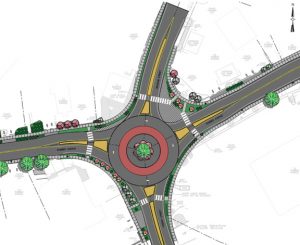
NAUGATUCK — The Board of Mayor and Burgesses has given its blessing to move forward with a modern roundabout as part of a Rubber Avenue reconstruction project.
The board voted 8-0 Aug. 6 to proceed with the roundabout, which will be built at the four-way intersection of Rubber Avenue and Meadow and Cherry streets. The roundabout will replace the traffic signals at the intersection.
The preliminary design is for a one-lane roundabout that is 120 feet in diameter with a raised island in the center. The roundabout requires some land from the Rite Aid property at the intersection to build. Splitter islands will be built where traffic approaches the roundabout to divide vehicles entering and exiting it. Vehicles that pull up to the roundabout yield to those inside it, before entering the roundabout.
Officials favored the roundabout, pointing to studies conducted by the Insurance Institute for Highway Safety and the Federal Highway Administration that state roundabouts reduce collisions and traffic congestion.
Lisa Slonus, a professional engineer with the firm Weston & Sampson, said modern roundabouts, by their design, are safer because cars travel through them at lower speeds and they reduce the number of points where cars can collide.
Scott Bushee, a highway design engineer with the state Department of Transportation who has designed six roundabouts in the state, said there will be times when some cars backup at the roundabout, but drivers won’t experience the delay they do now at the intersection.
A February memorandum from Weston & Sampson states that an average of 12,726 vehicles traveled through the intersection daily based on traffic counts taken in December 2018 while school was in session. The memorandum also states that traffic backed up anywhere from 75 feet to 550 feet at times at different parts of the intersection.
In his experience, Bushee said it takes about two to three months for people to get used to roundabouts, then they work well.
“I’m not going to lie to you, when it first opens up there’s going to be some growing pains,” he said.
While the board members all favored the roundabout, the discussion wasn’t without its questions.
Burgess Michael Bronko said he heard from residents who raised concerns about how the roundabout will impact children who walk through the intersection to go to school. He questioned how that will be addressed.
There is one crossing guard stationed at the intersection before and after school, Police Chief Steven Hunt said. After the roundabout is built, he said, the department will assign an officer at the intersection when school starts to get a feel for whether another crossing guard needs to be added.
Along with the safety and congestion reasons officials cited for favoring the roundabout, Mayor N. Warren “Pete” Hess felt it can also be a catalyst for the project to upgrade Rubber Avenue.
“Rubber Avenue needs a boost,” he said. “I mean that road has fallen apart over the years.”
The roundabout is part of a project to reconstruct Rubber Avenue from Elm Street to Melbourne Street. The project, which is slated to start next year, will include drainage improvements and new sidewalks and landscaping along the road.
The project will be funded through the state Local Transportation Capital Improvement Program, with the borough covering the design costs. Director of Public Works James Stewart said the design costs, which aren’t finalized yet, will be paid for from a $5 million capital bond previously approved by voters.














Track record:
1. High school solar panels- FAILURE
2. Maple hill brick bridge- FAILURE
3. Lower mill rate- FAILURE
4. Port of Naugatuck- Illusion
5. Roundabout? Not a good prognosis